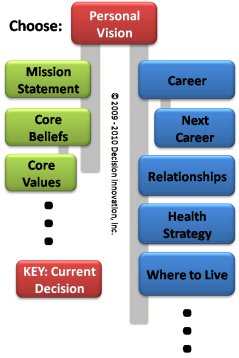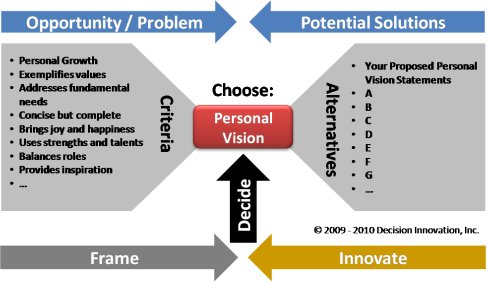Choose a personal vision statement to guide your important life decisions
A personal vision statement, when reviewed on a routine basis, can provide benefits in your career success, personal relationships and overall satisfaction with your life. As part of network of managed life decisions, your choice of a personal vision is a focusing decision that provides guidance and direction to all your major life decisions.
Your personal vision will address multiple dimensions of your life and could provide decision direction for spiritual development, work or career goals, family, social and community relationships, finances, self improvement, and fun.
Is there one right answer?
 Developing your personal vision decision can be compared to developing a budget or an investment portfolio. In this case, instead of allocating money to budget or investment categories, you will be allocating your time and energy to the areas that will be important to living the life you envision. This will be a multiple answer decision that provides focus and balance for the expenditure of your time, money, and talents. You are the CEO of your life, and your vision provides direction for the use of your personal resources. While it is better to develop your personal vision as early in your life as possible, it's never too late.
Developing your personal vision decision can be compared to developing a budget or an investment portfolio. In this case, instead of allocating money to budget or investment categories, you will be allocating your time and energy to the areas that will be important to living the life you envision. This will be a multiple answer decision that provides focus and balance for the expenditure of your time, money, and talents. You are the CEO of your life, and your vision provides direction for the use of your personal resources. While it is better to develop your personal vision as early in your life as possible, it's never too late.
A wonderful benefit of this decision is that it will help you decide where to say no. Given the ever increasing distractions, diversions, and demands for our time we encounter, you can use your personal vision statement to help identify activities and requests that are leading you away from the direction you intended. This is extremely powerful, and can increase your decision effectiveness on multiple fronts, including balancing where to spend your limited time.
Frame the criteria you use to decide what's part of your life vision
Creating your personal vision statement is a visualization activity where you project yourself into the future and form a picture of you living your most fulfilled life. It is important that you paint a complete picture to avoid leaving out something that is truly important. You don't want to arrive at your future state and find out that you left out a critical element.
Here are some criteria you can consider in developing your vision statement.
- Personal Growth - Growing over time allows me to increase my contribution, effectiveness, and knowledge to the benefit of myself and others.
- Exemplifies values - My vision will convey living my values.
- Addresses fundamental needs - My vision should address my basic physical, mental, emotional, social, and spiritual needs.
- Concise but complete - My vision will succinctly convey all elements important to living a fulfilled life.
- Brings joy and happiness - Doing things that bring joy will keep me motivated and productive.
- Uses strengths and talents - Aligning with my current strengths and talents will allow me to maximize my contribution in the time I have and increase my enjoyment.
- Balances roles - My vision will suggest a balance of the roles I seek to fill at home, at work and in the community.
- Provides inspiration - My vision inspires and motivates me.
Additional criteria that can also be considered include providing life anchors, uniqueness, and long lasting. Try to find criteria that ensure completeness and others that can help prune your vision for things that are less important.
Innovate alternatives using your decision criteria
A technique that can be helpful in generating alternatives for your personal vision statement involves using the success criteria developed from the framing stage. You can use two or more criteria to form a statement that would evaluate well for the criteria being considered. For example, let's consider the following criteria: Addresses fundamental needs and Balances roles. A statement you could create is, "I stay healthy with routine exercise with family and friends at the local health club." This statement might score well with both these criteria because it addresses a fundamental need of good health while helping to balance roles between personal, family and friends.
Recognize that you can do this with other criteria until you have generated enough alternatives to cover the areas that will give complete coverage to what will be important in your vision statement.

Complete your vision statement by deciding which elements to keep
Now that you have a number of statements that can be part of your personal vision, it's time to put on your CEO hat and ensure that each statement provides something that is really important. Expect to create a high level plan that can provide guidance to your life decisions on an ongoing basis. Use your criteria to eliminate some items that aren't as important so that you feel that you have the personal resources to work toward your vision. A little stretch is good, but balance will generally provide for success in the long run.
Expect your vision to change over time and manage the consequences
Unlike a goal, you should build a vision that will not change quickly. Your vision provides a strategic roadmap into the future. Similar to a business strategy, if you are redoing it every year, you have created a one year plan instead of a personal vision statement.
However, do expect that your personal vision statement will evolve over time. You will need to update your vision as you mature and change in character to reflect your changing view on what you originally thought to be important. Also, as you gain knowledge, skills and experience you may find yourself fulfilling elements of your vision sooner than you thought. With a network of managed life decisions you will have the tools to reflect these changes into your other important life choices.
Return from Personal Vision Statement to Personal Decision Making

